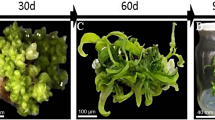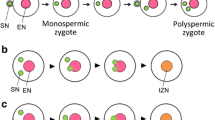Abstract
Most Liliaceae plants have the tetrasporic Fritillaria-type embryo sac and normally form diploid embryos and pentaploid endosperms derived from a 4:1 maternal-to-paternal genome ratio (4m:1p) after double fertilization. Here we characterize embryo sac and endosperm formation in Tulipa spp. of Liliaceae. Chromosome analysis using seeds derived from 2x × 2x crosses of Tulipa gesneriana (2n = 2x = 24) identified diploid chromosome number in the endosperm. Similarly, flow cytometric analysis confirmed diploid endosperm formation in T. gesneriana, T. fosteriana (2n = 2x = 24) and T. greigii (2n = 2x = 24). To further study the possible mechanism of diploid endosperm formation, we made interploidy crosses of triploid (2n = 3x = 36) × diploid in which aneuploid seeds with various chromosome numbers (2n = 25–36) were produced. Again, flow cytometric analysis confirmed the same ploidy level in both embryos and endosperms at all aneuploidy levels, suggesting that only a single haploid polar nucleus contributes to endosperm formation at fertilization. Histological observation further confirmed the physical separation of two polar nuclei by a large vacuole in the Fritillaria-type embryo sac of T. gesneriana that appeared to prevent the fusion of the two polar nuclei that originated at the micropylar and chalazal ends before fertilization. Taken together, these results indicate that diploid endosperms (1m:1p) are normally formed in Tulipa spp. by fusion of the micropylar polar nucleus (n) and a spermatid (n) but not by normal triple fusion. We also show that tulip endosperm partially overcomes the triploid block mechanism that occurs in interploidy crosses. Based on these observations, the possible role of triple nuclear fusion in double fertilization is discussed.






Similar content being viewed by others
References
Adams S, Vinkenoog R, Spielman M, Dickinson HG, Scott RJ (2000) Parent-of-origin effects on seed development in Arabidopsis thaliana require DNA methylation. Development 127:2493–2502
Akutsu M, Kitamura S, Toda R, Miyajima I, Okazaki K (2007) Production of 2n pollen of Asiatic hybrid lilies by nitrous oxide treatment. Euphytica 155:143–152
Bambacioni V (1928a) Ricerche sulla ecologia e sulla embriologia di Fritillaria persica L. Ann Bot 18:7–37
Bambacioni V (1928b) Contributo alla embriologia di Lilium candidum L. RC Acad Science, Lincei 8:612–618
Bambacioni V, Giombini A (1930) Sullo sviluppo del gametofito femminile in Tulipa Gesneriana L. Ann Bot 18:373–386
Bambacioni-Mezzetti V (1931) Nouve ricerche sull’embriologia delle Giliaceae. Ann Bot 19:365–382
Bamford B, Reynard GB, Bellows JM Jr (1939) Chromosome number in some tulips hybrids. Bot Gazette 101:482–490
Baroux C, Spillane C, Grossniklaus U (2002) Evolutionary origins of the endosperm in flowering plants. Genome Biol 3:1026.1–1026.5
Batygina TB (2005) Embryology of flowering plants: terminology and concepts. Science Publishers, Enfield
Bryan EB (2002) Bulbs. Timber Press, Inc, Portland, pp 454–462
Cooper DC (1935) Macrosporogenesis and development of the embryo sac of Lilium henryi. Bot Gazette 97:346–355
Danilevskaya ON, Hermon P, Hantke S, Muszynski MG, Killipara K, Ananiev EV (2003) Duplicated fie genes in maize: expression pattern and imprinting suggest distinct functions. Plant Cell 15:425–438
Davis GL (1966) Systematic embryology of the angiosperms. Wiley, New York
Ehlenfeldt MK, Ortiz R (1995) Evidence on the nature and origins of endosperm dosage requirements in Solanum and other angiosperm genera. Sex Plant Reprod 8:189–196
Freidman WE (1995) Organismal duplication, inclusive fitness theory, and altruism: Understanding the evolution of endosperm and the angiosperm reproductive syndrome. Proc Natl Acad Sci USA 92:3913–3917
Friedman WE, Williams JH (2004) Developmental evolution of the sexual process in ancient flowering plant lineages. Plant Cell 16:S119–S132
Haig D, Westoby M (1988) Inclusive fitness, seed resources, and maternal care. In: Lovett Doust J, Lovett Doust L (eds) Plant reproductive ecology. Oxford University Press, Oxford, UK, pp 60–79
Haig D, Westoby M (1991) Genomic imprinting in endosperm; its effect on seed development in crosses between species, and between different ploidies of the same species, and its implications for the evolution of apomixes. Philos Trans R Soc Lond B 333:1–13
Iizuka M, Ikeda A (1968) Induction of polyploidy in Lilium formosanum Wallace. Jpn J Genet 43:95–101
Johnston SA, den Nijs TPM, Peloquin SJ, Hanneman RE Jr (1980) The significance of genic balance to endosperm development in interspecific crosses. Theor Appl Genet 57:5–9
Kato A (1997) An improved method for chromosome counting in maize. Biotech Histochem 72:249–252
Kihara H, Nishiyama I (1932) Different compatibility in reciprocal crosses of Avena, with special reference to tetraploid hybrids between hexaploid and diploid species. Jpn J Botany 6:245–305
Killingback S (1990) Tulips: an illustrated identifier and guide to cultivation. Chartwell Books, New Jersey
Kinoshita T (2007) Reproductive barrier and genomic imprinting in the endosperm of flowering plants. Genes Genet Syst 82:177–186
Lin BY (1984) Ploidy barrier to endosperm development in Maize. Genetics 107:103–115
Maheshwari P (1948) The angiosperm embryo sac. Bot Rev 14:1–56
Maheshwari P (1950) An introduction to the embryology of angiosperms. McGraw-Hill, New York
Marasek A, Okazaki K (2008) Analysis of introgression of Tulipa fosteriana genome into Tulipa gesneriana using GISH and FISH. Euphytica 160:217–230
Masterson J (1994) Stomatal size in fossil plants: evidence for polyploidy in majority of angiosperms. Science 264:421–424
Murashige T, Skoog F (1962) A revised medium for rapid growth and bioassays with tobacco tissue culture. Physiol Plant 15:473–497
Nishiyama I, Inomata N (1966) Embryological studies on cross incompatibility between 2x and 4x in Brassica. Jpn J Genet 41:27–42
Pechenitsyn VP (1972) The double fertilization in species of Tulipa with Fritillaria-type embryo sac. Bot Zh 57:465–469
Romanov ID (1938) A new form of the Adoxa type embryo sac in Tulipa tetraphylla und T. ostrovskiana. Reports USSR Acad Sci 19:113–115
Romanov ID (1939) Two new forms of embryo sac in the genus Tulipa. Reports USSR Acad Sci 22:140–142
Sayama H, Moue T, Nishimura Y (1982) Cytological study in Tulipa gesneriana and T. fosteriana. Jpn J Breed 32:26–34
Scott RJ, Spielman M, Balley J, Dickinson HG (1998) Parent-of-origin effects on seed development in Arabidopsis thaliana. Development 125:3329–3341
Stebbins GL (1971) Chromosome evolution in higher plants. Columbia University Press, New York
Stebbins GL (1976) Seeds, seedlings, and the origin of angiosperms. In: Beck CB (ed) Origin and early evolution of angiosperms. Columbia University Press, New York, pp 300–311
Stewart-Cox JA, Britton NF, Mogie M (2004) Endosperm triploidy has a selective advantage during ongoing parental conflict by imprinting. Proc R Soc Lond B 271:1737–1743
Takamura T, Miyajima I (1996) Cross-compatibility and the ploidy of progenies in crosses between diploid and tetraploid cyclamen (Cyclamen persicum Mill). J Jpn Soc Hort Sci 64:883–889
Tsuchiya T (1960) Studies on cross compatibility of diploid, triploid and tetraploid barleys. 2. Results of crosses between triploid, diploids and induced autotetraploids. Jpn J Genet 35:337–343
Upcott M, Philp J (1941) The genetic structure of Tulipa. IV. Balance, selection and fertility. J Genetics 38:91–123
Williams JH, Friedman WE (2002) Identification of diploid endosperm in an early angiosperm lineage. Nature 415:522–526
Williams JH, Friedman WE (2004) The four-celled female gametophyte of Illicium (Illiciaceae; Austrobaileyales): implications for understanding the origin and early evolution of monocots, eumagnoliides, and eudicots. Am J Bot 91:332–351
Yadegari R, Drews GN (2004) Female gametophyte development. Plant Cell 16:S133–S141
Acknowledgments
The authors thank Dr. Takashi Okada, CSIRO Plant Industry, Adelaide, Australia, for his invaluable comments. This research is supported in part by a Grant-in-Aid for Scientific Research (No. 19580024) from the Ministry of Education, Culture, Sports, Science and Technology, Japan and in part by a Research Project for Utilizing Advanced Technology in Agriculture, Forestry and Fisheries from the Ministry of Agriculture, Forestry and Fisheries of Japan.
Author information
Authors and Affiliations
Corresponding author
Additional information
Communicated by Scott Russell.
Rights and permissions
About this article
Cite this article
Mizuochi, H., Matsuzaki, H., Moue, T. et al. Diploid endosperm formation in Tulipa spp. and identification of a 1:1 maternal-to-paternal genome ratio in endosperms of T. gesneriana L.. Sex Plant Reprod 22, 27–36 (2009). https://doi.org/10.1007/s00497-008-0088-6
Received:
Accepted:
Published:
Issue Date:
DOI: https://doi.org/10.1007/s00497-008-0088-6




